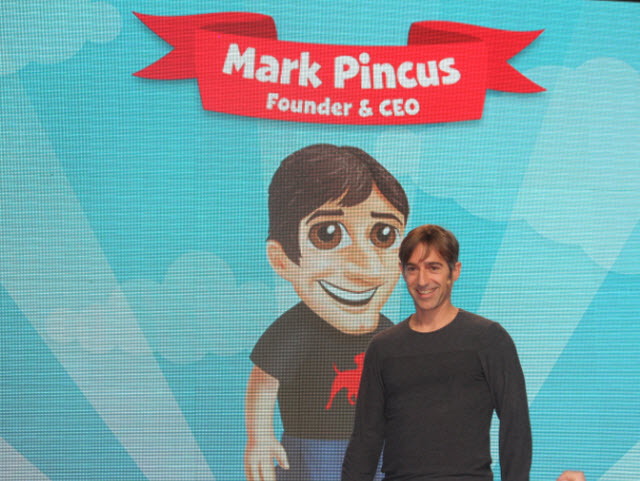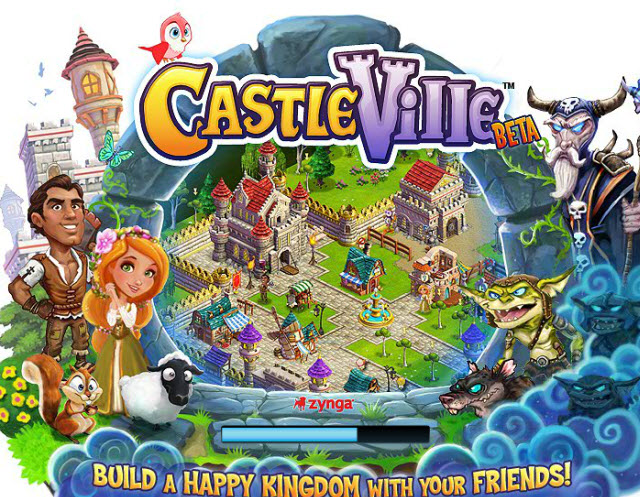CastleVille saves the day
In late October and November, the stock market was still volatile. Toward the end of November, a new IPO window opened as companies such as Yelp filed for IPOs and Angie’s List succeeded in going public. But Zynga had its ace in the form of CastleVille, a game whose purpose was to bring massively multiplayer online role-playing games to the larger mass market.
Zynga bought a company called Bonfire Studios in October, 2010. It included a number of seasoned developers who had worked at Microsoft’s Ensemble Studios, the creator of Age of Empires. As Microsoft shut Ensemble down, Bonfire was born. Zynga pounced on it and renamed it Zynga Dallas.
Bill Jackson (pictured right), creative director of Zynga Dallas and a former Ensemble employee, had led the development of the game for more than a year. Now Zynga Dallas was launching CastleVille, the latest in the series of Ville games that had become the mainstay of Zynga’s simulation games. The title mashed up Zynga’s usual cartoon style, which had a wide appeal among Facebook users, with more interesting game play than it had in the past.
“CastleVille takes Zynga’s Ville legacy to a new level of social,” Jackson said.
The game was a goofy title inspired by movies like Shrek, though its play style wasn’t an exact copycat of anything else in the market. Zynga launched the game on Nov. 14. On that day, The Sims Social was no longer a huge threat. Zynga had roughly 40 percent of the market share for social games on Facebook, with more than 45 million daily active users. EA had just 12.5 million daily active users.
After six days, CastleVille had 5 million users. About 68 percent of CastleVille players were playing at least twice a day. Zynga said that in six days, 135,176,035 quests had been completed. Players had expanded into new parts of the map (covered by dark Gloom spaces) a total of 4,594,750 times. About 23,845,983 beasties had been banished. Some 8,262,768 baby cows had been raised. And 182,360 Bubbly Grogs had been crafted.
Seventeen days after CastleVille launched, it had 20.8 million monthly active users. A full year after CityVille had launched, CastleVille had taken the title of the fastest-growing game in history. On Dec. 12, 2011, CastleVille had 31.6 million monthly active users, according to AppData. If anything would make investors happy, it was another hit game. And this was just one of the first launches in what Zynga’s No. 2 man, John Schappert, would call “the most active launch period in the history of the company.”
Going public
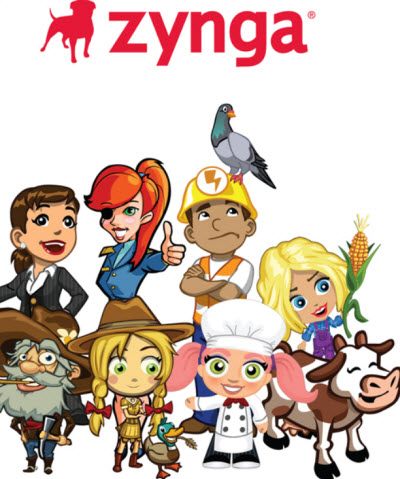 Back in 2009, there was a time when Zynga got nothing but good press. At that time, Mark Pincus said he should have been thrilled that Fortune, Forbes, and BusinessWeek had all written about his company, but he wasn’t.
Back in 2009, there was a time when Zynga got nothing but good press. At that time, Mark Pincus said he should have been thrilled that Fortune, Forbes, and BusinessWeek had all written about his company, but he wasn’t.
“I should feel happy, but I feel shitty,” he said. “I feel like the emperor with no clothes.”
He said that both social games and Zynga have a lot of potential, but they also had a long way to go before they could be considered successes.
When you headed for imminent failure, the best thing you can do, Pincus said, is to be in a position where you can intellectually and emotionally own your failure. At that point, he said, “You know you can control your own destiny.”
By 2011, however, there was no longer much danger of imminent failure.
As the IPO season neared the end of the year, Zynga was wrapping up its details. It changed its accounting to suit the regulators on Oct. 14. For the period ended Sept. 30, Zynga said net income was $12.5 million in third quarter ended Sept. 30, down 54 percent from a year ago. Revenue was $307 million, up 80 percent. Bloomberg reported Zynga would likely go public after Thanksgiving. Zynga’s destiny would be in the hands of investors.
Competitors tried to stir up negative stories about how Zynga treated its employees. All of a sudden, Mark Pincus was the emperor with no clothes again. The Wall Street Journal reported that Zynga’s Pincus had been leaning on poor performers to give back their stock options. On Nov. 17, chief business officer Owen Van Natta resigned from his job. And the New York Times reported that Zynga’s employees were dissatisfied and that PopCap Games had been so alarmed about Zynga’s culture that it turned down a $950 million cash offer from Zynga in favor of the $750 million plus $550 million bonus from EA. Rovio also reportedly turned down a $2.4 billion Zynga offer.
But Zynga didn’t seem to worry about the negative press. The company filed its plan to raise up to $1 billion at a $8.9 billion valuation on Dec. 2, with a per share price range of $8.50 to $10. It planned to initiate a nine-day roadshow to pitch investors. It would price the stock on Dec. 15 and start trading on Dec. 16. It was the last real window of the year for going public, and the company decided to take it.
The amount of money being raised and the valuation were a lot smaller than what everyone had expected, which was a $15 billion to $20 billion valuation. Worse, the valuation was less than it had been during the company’s previous round, which means the most recent investors were seeing the value of their investment in Zynga decline. If the price rises above $14 a share, those investors should be OK.
But even at the reduced amount, Zynga would be worth more than EA at $7 billion, although EA had four times the revenue. That was a long way from the good old days. Andrew Cleland, the partner at Comcast Ventures, recalled that Pincus had told him Zynga would be more valuable than EA in five years. In reality, it took Pincus just a couple of years.
Cleland’s calculations suggested that Zynga would spend more than $500 million in research and development in 2012, and that Pincus probably wasn’t managing for profitability in that year. The long-term vision demanded heavy investment, not quick profits.
“Zynga is a remarkable venture story, and the company’s impending IPO is a huge moment for the games industry — it marks the coming of age of the West’s leading proponent of casual, free-to-play gaming,” Cleland wrote. “With the timing for the company’s roadshow now seemingly confirmed, what should we expect from Zynga as it goes public? The answer reflects Pincus’ exceptional level of ambition and has implications both for how investors should think about the company and how other developers manage their go-to-market strategies.”
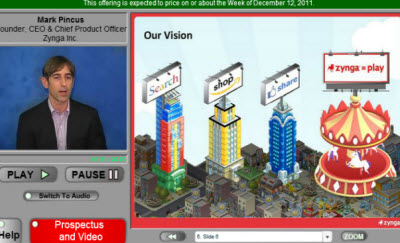 But Cleland’s long view might not have been shared by investors spooked about the European economy and Zynga’s own slowing growth. Where would Zynga’s new users come from in the wake of reinvigorated competition? To slide in value from $20 billion to $10 billion from July to December was almost as precipitous a drop as Zynga’s rise. The company was no longer walking on water. Now it had to earn every bit of respect and credibility. The reaction from the employees has been anger, in part, because the value of what they own is half of what they thought it was.
But Cleland’s long view might not have been shared by investors spooked about the European economy and Zynga’s own slowing growth. Where would Zynga’s new users come from in the wake of reinvigorated competition? To slide in value from $20 billion to $10 billion from July to December was almost as precipitous a drop as Zynga’s rise. The company was no longer walking on water. Now it had to earn every bit of respect and credibility. The reaction from the employees has been anger, in part, because the value of what they own is half of what they thought it was.
Once the company unveiled its investor roadshow, Pincus finally had a chance to make his pitch to everybody about why Zynga had a bright future. He said that he expected the number of gamers to double from 1 billion in 2011 to 2 billion in the next five years. About 18 billion apps were likely to be downloaded in 2011, and that would quadruple in five years. And $9 billion would be spent in 2011 on virtual goods, and that would triple in five years.
On mobile, Zynga had 11.1 million daily active users in October, up from 991,000 a year earlier. That’s a much smaller share of the overall mobile gaming market, but the growth rate is impressive. Zynga bought much of that with its acquisition of Newtoy, but it was still good progress.
Zynga’s ad revenue is $55 million, up 162 percent from a year ago. Advertisers include Best Buy, which had a campaign where players in CityVille built 8 million new Best Buy stores in the game. Ads are just 5 percent of total revenues now, but are growing. That represents a vast revenue opportunity. If Zynga makes just $1 a month in ad revenue from each of its 200 million users, that would amount to $2.4 billion in revenue a year.
The good thing about ads, Wehner said, is that they can be inserted long after a game launches. FarmVille launched in June 2009, but its Lady Gaga sponsorship was launched in May 2011. Hence, Zynga has some significant opportunities to backfill on revenue, making ad money and better sales per user with older games.
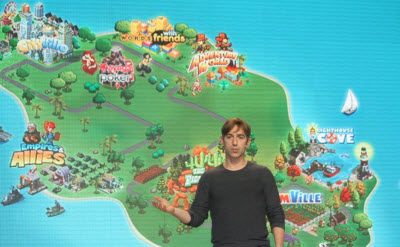 During the road show, Pincus reportedly said that Zynga might be able to double its number of paying users. Right now, about 2.5 percent, or 7.7 million users, pay money for virtual goods in games. It was no easy task, but if Zynga could double that, it could potential double the revenues of the company.
During the road show, Pincus reportedly said that Zynga might be able to double its number of paying users. Right now, about 2.5 percent, or 7.7 million users, pay money for virtual goods in games. It was no easy task, but if Zynga could double that, it could potential double the revenues of the company.
Michael Pachter, a research analyst at Wedbush Securities who specializes in games and digital media, said there are several scenarios in which Zynga could double its paid user base within the next one to two years. The two key drivers of growth will be Facebook and mobile devices.
Pachter said that if Facebook hits 1 billion users, the number of people who play Zynga games will almost certainly increase in tandem. And if this happens, Zynga could still be close to doubling the number of paid users it has without significantly shifting the total proportion of Facebook users who play its games.
Zynga’s John Schappert said the company will launch new games, enter new international markets, expand to new platforms from Google+ to Tencent to Zynga.com, and grow its markets in mobile.
“Why now?” Schappert asked. “We are entering the most active launch cycle in the history of the company.”
“We believe it’s the most powerful business model in entertainment,” Schappert said. In other words, if you think about Zynga as an investment, it seems like a bargain at a $10 billion valuation.
When Zynga goes public, the stock market will put that notion to the ultimate test. And if all goes well, Mark Pincus, the Pretender and the Man Who Would Be King, will finally get to say to all of his detractors, “I told you so.”
VentureBeat's mission is to be a digital town square for technical decision-makers to gain knowledge about transformative enterprise technology and transact. Learn More
